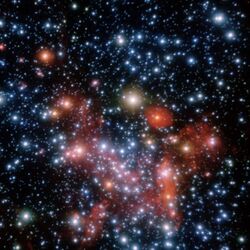Astronomy:Nuclear star cluster

A nuclear star cluster (NSC) or compact stellar nucleus (sometimes called young stellar nucleus) is a star cluster with high density and high luminosity near the center of mass of most galaxies.[1]
NSCs are the central massive objects of fainter, low-mass galaxies where supermassive black holes (SMBHs) are not present or are of negligible mass. In the most massive galaxies, NSCs are entirely absent. Some galaxies, including the Milky Way, are known to contain both a NSC and a SMBH of comparable mass.[2]
Properties
Nuclear star clusters are found in most galaxies that can be resolved sufficiently:[3]
- at least 50% of all early spiral galaxies (types Sa-Sc)
- at least 75% of all late spiral galaxies (types Scd-Sm)
- at least 70% of all spheroidal galaxies (types S0 and E).
NSCs are the densest known star clusters in the Universe. With apparent magnitudes between -14 and -10 mag in the infrared, they are on average 40 times brighter than globular clusters, although their effective radii are not larger than 2 to 5 parsecs. With a dynamic mass of 106 to 108 solar masses, they are at the upper end of the values reached by globular clusters.[3]
The majority of nuclear star clusters contain a mix of old (at least one billion years old) and young stellar populations and show signs of star formation within the last 100 million years.[2]
Formation
Although the mechanisms behind their formation are not entirely known, hypotheses provide four possibilities:[4] [5]
- Nuclear star clusters originate somewhere else and are captured by a central black hole.
- Nuclear star clusters are due to an incidence of gas at some distance from the center of the galaxy.
- A combination of the above possibilities whereby the gravitational potential of a trapped object, such as the nucleus of a dwarf galaxy, triggers new star formation by incident gas near the galactic center.
- Nuclear star clusters are created by merging star clusters with subsequent migration to the galactic center due to dynamical friction with background stars. [6]
Relationship with globular clusters
Because nuclear star clusters occur in most galaxy species, they should still be present in the halo of the resulting galaxy after the fusion of galaxies. This is a hypothesis for the formation of globular clusters. Thus, globular clusters could be the remains of nuclear star clusters excluded from gas incidence, in which no new star formation occurs.[7]
According to other hypotheses, however, the nuclear star clusters could be the result of a fusion of globular clusters captured by a supermassive black hole in the center of the galaxy and dynamically destroyed.[8]
References
- ↑ Ferrarese, L.; Merritt, D.; Eckart, A. (2009). "The nuclear star cluster of the Milky Way: proper motions and mass". Astronomy & Astrophysics 502 (1): 91–111. doi:10.1051/0004-6361/200810922. Bibcode: 2009A&A...502...91S.
- ↑ 2.0 2.1 Nishiyama, S.; Schödel, R. (2012). "Young, Massive Star Candidates Detected throughout the Nuclear Star Cluster of the Milky Way". Astronomy & Astrophysics 549: A57. doi:10.1051/0004-6361/201219773. Bibcode: 2012yCat..35490057N.
- ↑ 3.0 3.1 Boeker, T (2009). "Nuclear Star Clusters". Proceedings of the International Astronomical Union 266: 58–63. doi:10.1017/S1743921309990871. Bibcode: 2010IAUS..266...58B.
- ↑ Antonini, F. (2012). "Origin and growth of nuclear star clusters around massive black holes". The Astrophysical Journal 763 (1): 62. doi:10.1088/0004-637X/763/1/62. Bibcode: 2013ApJ...763...62A.
- ↑ Madigan, A.; Levin, Y.; Pfuhl, O.; Gillessen, S.; Genzel, R.; Perets, H. B. (2013). "On the origin of the B-stars in the Galactic center". The Astrophysical Journal 784 (1): 23. doi:10.1088/0004-637X/784/1/23. Bibcode: 2014ApJ...784...23M.
- ↑ Capuzzo-Dolcetta, R. (1993). "The Evolution of the Globular Cluster System in a Triaxial Galaxy: Can a Galactic Nucleus Form by Globular Cluster Capture?". The Astrophysical Journal 763 (1): 62. doi:10.1086/173189. Bibcode: 1993ApJ...415..616C.
- ↑ Scott, N.; Graham, A. (2012). "Shifting Fundamentals: Scaling Relations involving Nuclear Star Clusters and Supermassive Black Holes". The Astrophysical Journal 763 (2): 76. doi:10.1088/0004-637X/763/2/76. Bibcode: 2013ApJ...763...76S.
- ↑ Capuzzo-Dolcetta, R. (2013). "Galactic Nuclear Cluster Formation Via Globular Cluster Mergers". Memorie della Societa Astronomica Italiana 84: 167. Bibcode: 2013MmSAI..84..167C.
 |

